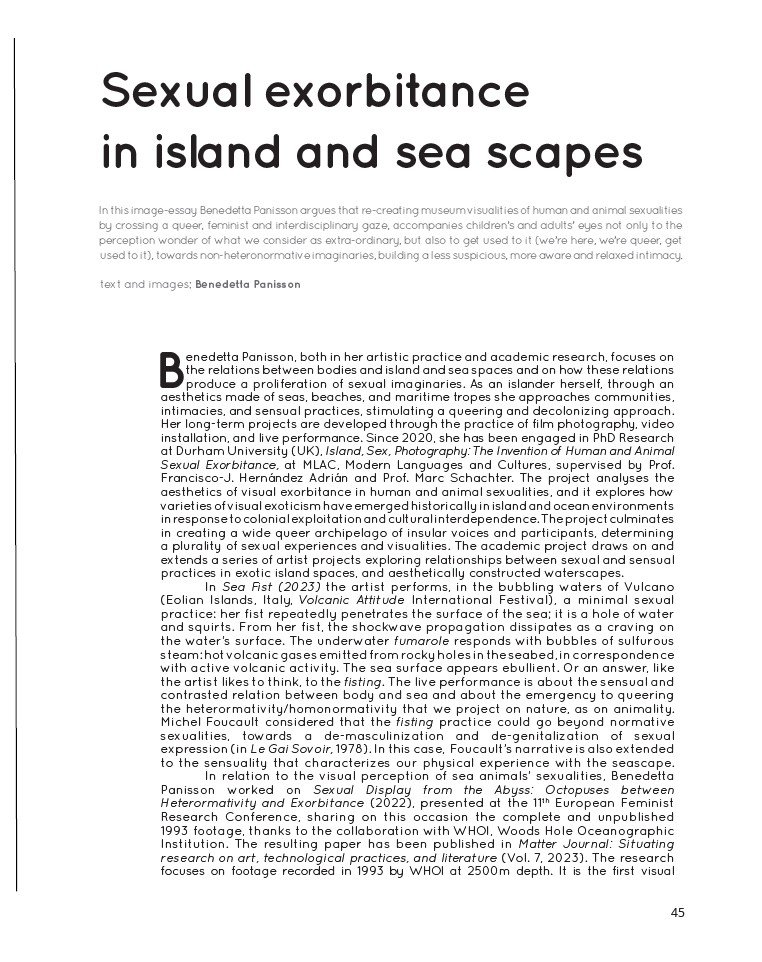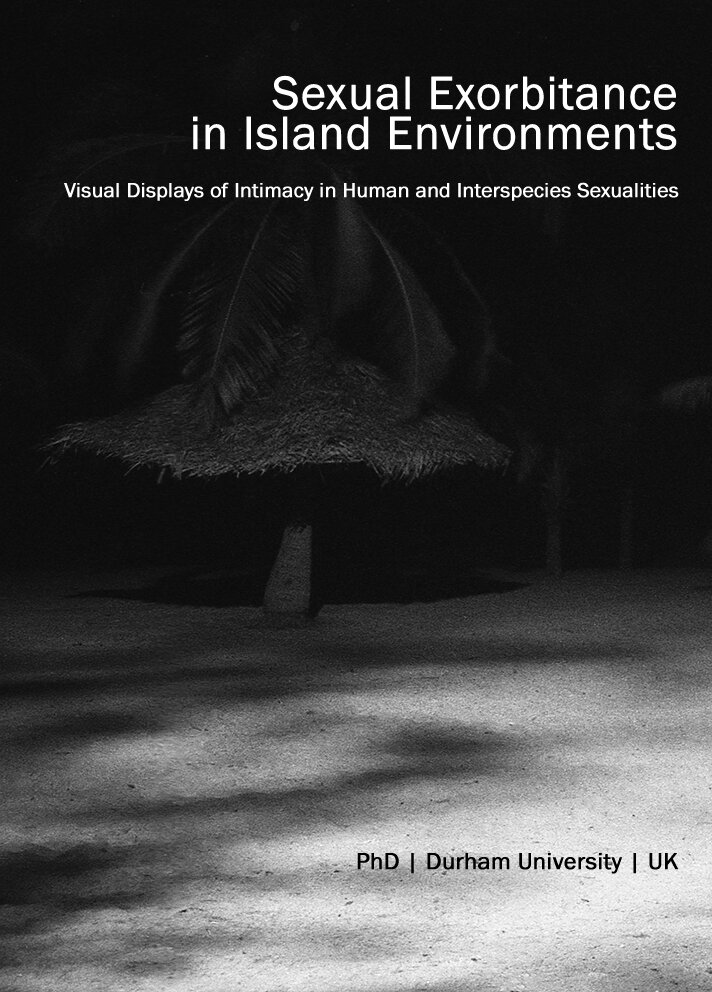Academic Collaborations
Felice di essere artista in residenza @casadegliartisti_art e onorata di avere con me come special guest Lorenzo Bernini @quellodelsessualepolitico
Vi aspettiamo venerdì 18 aprile 2025 alle 18.45, alla Casa degli Artisti, Corso Garibaldi, 89/A, Milano
SEXUAL DISPLAY FROM THE ABYSS
Benedetta Panisson, artista residente presso Casa degli Artisti, insieme a Lorenzo Bernini, una delle più autorevoli voci del dibattito queer italiano, racconteranno, in un dialogo informale e aperto con il pubblico, un video del 1993 realizzato da WHOI (Woods Hole Oceanographic Institute), in cui due polpi maschi e di due specie diverse compiono un atto sessuale nell’abisso oceanico. Il portato estetico e la storia queer di questa visualità, tra censure e interpretazioni oggi re-immaginabili, lasceranno emergere, dall’abisso, quanto la sessualità, anche quella animale, sia un complesso costrutto umano. Il video sarà parte della futura mostra presso Casa degli Artisti.
Foto: Courtesy of Richard Lutz, Rutgers U./NSF/DSV Alvin/1993 © Woods Hole Oceanographic Institution
Un grazie speciale a @susannaravelli @giuliarestifo__ e a tutto il team di Casa degli Artisti
Honored to be part of the Conference "Insular weathers, global atmosphere: Exploring the aerial histories of islands" with my project Climate Changes Sex . at the Historical and Popular Art Museum of Aegina Islands, Nov. 1-3, 2024
Special Thanks to the Organization Committee:
Robert-Jan Wille, History and Philosophy of Science, Freudenthal Institute, Utrecht University
Vladimir Jankovic, Centre for the History of Science, Technology and Medicine (CHSTM), The University of Manchester
George N. Vlahakis, Laboratory of Science, Technology and Medicine Communication, Hellenic Open University
Full Programme here: https://meteohistory.org/2024/insular-weathers-global-atmospheres-exploring-the-aerial-histories-of-islands/#more-1399
Honored to present my "Queering the Marriage of the Sea" at the conference “Materiality at the Intersection of Ecology and Religious Studies”, organized by Fondazione Giorgio Cini (the Centre for Comparative Studies of Civilisations and Spiritualities), Harvard Divinity School (Center for the Study of World Religions), @harvarddivinity, Ca’ Foscari University of Venice (THE NEW INSTITUTE Centre for Environmental Humanities – NICHE, the Center for the Study of Lived Religion, and the Department of Asian and North African Studies), University College Dublin (Irish Research Council Government of Ireland) @universitycollegedublin
Abstract
In 1000 the doge of Venice, Pietro II Orseolo, married the sea. The union took place at the port mouth of of S. Nicolò. He was clad in ermine and with a horn on his head; he slowly paraded aboard the Bucintoro, to such an extent barded with gold statues that it became an object unfit for navigation. Blessed water was poured into the water, a ring was thrown into the waves. Desposamus te, mare. In signum veri perpetuique dominii, the formula says. The ceremony was made sacred by Pope Alexander III in 1173 with the words, Doge of Venice, this is the wedding ring of your marriage to the sea. From now on, we want you and your successors to marry her every year. The doge is a male, therefore, the sea a female. The ceremony, for centuries, represented a spiritual gesture of mutual protection: the male doge by taming her, the female sea by promising not to provoke unfavorable storms. The political and economic value of dominance over the seas, which the Serenissima particularly cared about, was also stated. Both the gender issue and the fact that domination of one subject over another can be acted out through marriage in a patriarchal form, in this case between human and waterscape, remain unrelevant details. In light of international and legal acknowledgements, such as the Tiwi Island case, analyzed by Veronica Strang, where native people declared that Santos company drilling could spiritually and ecologically destabilize the entire island community, leaves us to ponder the question: if spirituality still values to protect an ecological system, and whether this intersects some form of genderization of the aquatic environment, the concept of ownership, as Strang herself points out, it suggests that the material qualities water elude such conceptual fixity, and enable – indeed necessitate – more fluid forms of ownership. My paper focuses precisely on this proposal of fluidity to be intertwined with the question of gender, when this is attributed to a sea, as in the case of the Venetian marriage of the sea.
May 21-23, Venice
https://www.cini.it/eventi/convegno-materiality-at-the-intersection-of-ecology-and-religious-studies
Sexual Display from the Abyss: Octopuses between Heteronormativity and Exorbitance published on Matter Journal, Vol. 7 (2023): Situating research on art, technological practices and literature | Read it here: https://revistes.ub.edu/index.php/matter/article/view/42245/39307
Abstract
This paper focuses on a footage recorded in 1993 by Woods Hole Oceanographic Institution at 2500m depth. It is the first visual experience of sexual activity between abyssal octopuses in their oceanic habitat: they are two males of two different species. This paper aims to analyze the gendered, affective, and moral structures that have produced texts and voice-offs in relation to this visuality, letting emerge how a transcultural, feminist, queer, and artistic gaze can lead to a reparative stance, beyond a replicated heteronormativity perceived as threatening, towards a more relaxed intimacy with animal sexualities, including a hybrid sense of eroticism that accompanies the human attraction for visual sexualities.
The Sexuality of the Uncontacted on a Video Tape | CRASSH I Indigenous studies in the United Kingdom and Europe I Session 9 | Cambridge University | 2023
The Sexuality of the Uncontacted on a Video Tape | Cambridge University | Indigenous Studies Discussion Group | Sept 2022
Keywords
visual studies, islands, indigenous studies, sexual studies, queer studies.
Abstract
My PhD research (Durham University) focuses on visual productions in relation to sexualities in insular territories. Since the late nineteenth century, ethnography, photography, and then video, have structured a visual exploitation of what in the eyes of Western explorers was considered hostile, perverse, and nudity to be tamed, creating imaginaries, erotic exoticism, and data deemed scientific. A form of study aimed at creating sexual peripheralities in territorial peripheralities, such as oceanic islands. What culture and morality assimilates hostility with sexuality? In particular, a footage recorded in 1998 at North Sentinel (Andaman Islands), and analyzed by Vishvajit Pandya (2009), whose natives are still coonsidered as uncontacted, and preserved by Indian authorities as such, but spotted by British settlers, then anthropologists, and finally illegal tourism, shows one of the few approaches to the island. Coconuts are thrown from the boat, some natives pick them up, others perform sexual gestures considered by Indian authorities to be obscene, and a way of defending themselves. A critical question arises here: in 1998 how can the North Sentinel indigenous people, deemed unaltered by Western and Central Indian sexual-related cultures and morals, perform purposefully hostile sexual gestures? Here It is analized the notion of sexual diversity in those who study native peoples in oceanic islands, with the aim of defusing the hostility-sexuality pair.
Affiliation
Durham University (UK). PhD Research at MLAC (Modern Languages and Cultures), project supervised by Dr Francisco-J. Hernández Adrián and Dr. Marc Schachter. Benedetta Panisson is represented in Italy by OPR Gallery and PHROOM Platform.
Sexual Display from the Abyss: Octopuses between Heteronormativy and Exorbitance
11th European Feminist Research Conference, organized by AtGender (NL) and Milano-Bicocca University, 2022.
In relation to the visual perception of sea animals’ sexualities, Benedetta Panisson worked on Sexual Display from the Abyss: Octopuses between Heterormativity and Exorbitance (2022), presented at the 11th European Feminist Research Conference, sharing in this occasion the complete and unpublished 1993 footage, thanks to the collaboration with WHOI, Woods Hole Oceanographic Institution. The resulting paper has been published in Matter Journal: Situating research on art, technological practices and literature (Vol. 7, 2023). The research focuses on a footage recorded in 1993 by WHOI at 2500m depth. It is the first visual experience of sexual activity between abyssal octopuses in their oceanic habitat: they are two males of two different species. This paper aims to analyze the gendered, affective, and moral structures that have produced texts and voice-offs in relation to this visuality, letting emerge how a transcultural, feminist, queer, and artistic gaze can lead to a reparative stance, beyond a replicated heteronormativity perceived as threatening, towards a more relaxed intimacy with animal sexualities, including a hybrid sense of eroticism that accompanies the human attraction for visual sexualities.
Sexual Display from the Abyss: Octopuses between Heteronormativity and Exorbitance published on Matter Journal, Vol. 7 (2023): Situating research on art, technological practices and literature | Read it here: https://revistes.ub.edu/index.php/matter/article/view/42245/39307
(Courtesy of WHOI ©Woods Hole Oceanographic Institution, still from footage 4885)
Difficult Intimacy: Photographic Immersions in Benedetta Panisson’s Excess Island
by Francisco-J. Hernández Adrián (Durham University, UK)
No less acute than a paranoid position, no less realistic, no less attached to a project of survival, and neither less nor more delusional or fantasmatic, the reparative reading position undertakes a different range of affects, ambitions, and risks. What we can best learn from such practices are, perhaps, the many ways selves and communities succeed in extracting sustenance from the objects of a culture – even of a culture whose avowed desire has often been not to sustain them.
Eve Sedgwick
Excess Island culminates a decade-long investigation into sensory poiesis and photographic emotiveness that locates Western ways of seeing islands in what Eve Sedgwick, quoting Melanie Klein, calls “the reparative reading position.” The photographs that Panisson exhibits at OPR Gallery in Milan from September 2021 document acts of co-constitutive creation and recognition between two modern protagonists: the voluble, sexual, camera-wielding human, and the sublime, sentient, refractive, and potentially hostile biosphere. In this imaginary and photographed relation, who makes what and who constitutes whom? Panisson’s photographs display a thorough interrogation of the sensorium that lies beyond the common traveler’s sentimental reach because solitude and slow immersion are not usually included in the package holiday. Excess Island suspends the impetus to commodify environmental objects and demonstrates a commitment to sense and coexist on the margins of acceleration and consumerism.
These are almost invariably diurnal photographs that privilege contrast, shade, and subtle transitional moods. They are accented by an emotive colour palette that ranges from mineral (azurite and sulphur), to twilight and dawn (pale pink and light blue), to analog silvers and deep blacks. They include variations on light and airiness, glimpses of intense diurnal immersion, and occasional instances of overexposure. They dwell on the intimacy of the open air, the watchful perambulation of a found vista, and those scenes that fit photographic convention initially, but only to question it by amplifying the supreme importance of acts of passing – the barely perceptible passing of day, bird, child, cloud or wave. Scale is transported onto the realms of symbols and archetypes, but quickly re-figured as metaphoric, erotically-charged body-parts. And these parts of the traveler’s cultural baggage are the excessive, sentient, pulsating erotogenic zones that we carry and project onto the island. Panisson’s photographs chart and magnify the personal discovery of these expanding, folding, receding island regions. Yet they do not transact in exoticism, but participate in a reparative sense of self and place. Their reach is at once is island-bound and planetary.
The photographic sequences of Excess Island express a determination to transcend the cultural construction of natural light through photographic processes. They represent an investigation into primordial freedom, an art of immersion that questions the atmospheric conditions of instant, fleeting, and slow intimate intercourse in elemental spacetime. Waves swell, the sea rises and can be alluring and playful, or imposing on its littoral domains, and often exhilarating in its iodized moods of gentle and intention-less rhythms. Panisson’s photographs capture these elemental moods firmly and intuitively, not by extracting or leading, but by letting go of contextual detail so the pleasures and risks of cross-reflection can project a memorable encounter. These images examine how fleeting instances of unrecoverable time can be expanded through an excess of sensory discharges that structures the picture in the moment of capture.
These images are more experimental and exploratory than their apparent simplicity suggests. We will find no trace of the baroque articulations of the embattled senses that constitute the photographic asthetics of windsurfing, paragliding, or mountaineering. There is no amorous battle or epic struggle against the elements, but a placid pressure that measures the variable intensities of intimacy and detachment and rejects the relentless politics of metropolitan perspectivism that, as T. J. Demos argues, would explain the Anthropocene without attention to colonial, racist and gender violence, and capitalist exploitation. These are intimate portraits or sketches of un-representable experience that make us feel at ease with nude and vulnerable panoramas of the constructed seascape and islandscape. If we linger and listen, we understand that the sea, earth, and sky are no longer pure, except in our fantasies of an eternally discoverable planet. In Excess Island, the sea, earth, and sky bear the memory of future catastrophes.
These photographs narrate an expansive intimacy. The island assists the photographer in framing intimate atmospheres. But what are the insular areas of sensory pleasure in this decaying assemblage, in this frayed materiality? The sequences of this imaginary conversation expand under the deep blue skies, near the raucous waves, and in botanical and geological excursions that annotate the receding sounds of nature. A labour of intimate attention to the evidence of planetary turmoil commences in these echoing images, and we hear a multitude of palpitating orifices. Like our erotogenic mouths, the range of orifices that structure Excess Island like a reparative scaffolding are perceptive zones: generous receptacles, bearers of affective potential, emanators and receptors of libidinal relation. In Excess Island, the planetary environments onto which humans and other species project our bodily openings do not display a singular body, but a plethora of rhythmic cycles, events, and impending environmental transformations that pulsate like shoals of mouths and evoke the infant proto-languages that irrigate our sensory capacities.
The spectator will wonder if these images might not be photographic souvenirs, exotic images of loss and nostalgia. Or are they samples of a fast-disappearing modern imagination of the living planet? Svetlana Boym wrote tirelessly about displacement, exile, and nostalga. As we enter the emotional textures of pandemic, post-pandemic, and anticipatory “normality,” Boym’s reflections resonate uncannily with Panisson’s exhibition: “The illusion of complete belonging has been shattered. Yet, one discovers that there is still a lot to share. The foreign backdrop, the memory of past losses and recognition of transience do not obscure the shock of intimacy, but rather heighten the pleasure and intensity of surprise” (255). The uncompromising immediacy of Excess Island collapses and splinters across the multiple connective streams of photographic recognition, or what Boym identifies so perceptively as the shock of intimacy.
Glenn A. Albrecht imagines a nostalgia that struggles to find a sense of direction. Citing Albert Camus, he writes that ‘when the limits of one’s world, its laws and order, are destroyed by forces beyond one’s control, then home becomes not only toxic, it becomes “nostalgia without aim”.’ He explains: ‘I define “solastalgia” as the pain or distress caused by the ongoing loss of solace and the sense of desolation connected to the present state of one’s home and territory. It is the existential and lived experience of negative environmental change, manifest as an attack on one’s sense of place’ (34, 38). If Excess Island recovers a sense of belonging through an unesy identification with the “home” of analog photography, do we not discern in all these images a nostalgia for the nineteenth and twentieth centuries, or for the adventurous, twenty-decade-long process of photographic reproducibility? Watching some of these photographs, we remember that pre-digital world nostalgically, like a crumbling yet coherent shelter, like a now derelict common home.
The excess island interferes with the prescribed visualities of island exoticisms. Photographic prosopopoeia channels island voices, exertions, moods, and atmospheres. Island poses and eroticised environments in turn ventriloquize the capricious Planet that stares back at us with passionate indifference. In this relational interplay, we are all persons and we all perform as characters – the heroic seagull, the gathering storm, and the shoaling fish. Yet it is not the cast of characters that matters most, but the fact that all these photographs characterize us as spectators and co-participants in photographic nostalgia. These images capture and liberate experiences that lie outside exploitative regimes of production, reproduction, and dissemination: the “the compulsion of production” that Byung-Chul Han identifies as an overriding pathology of our neoliberal condition. Panisson’s sensory islandscapes demand our participation in the visionary images and soundscapes of an un-productive, queer, and reparative future of intimate relation.
There is no contemplative inaction in these photograhs, but an immersive and reparative longing (a longing for acts of “reparative reading” and “reparative knowing” in Sedgwick’s sense) to participate in the variable moods of the planet. Nor is there an obvious contrast, so common in contemporary island visualities, between packaged leisure and industrial extraction, the otium and negotium of tourist exploitation. These photographs wander to the limits of the gathering clouds, weather disturbances, atmospheric phenomena, meteora. They form sensory interstices, folds, and perspectives that long for undisturbed encounters with island lives that by turns fly, erupt, recede, and deflect interpelation. Panisson’s images reflect on our contemporary appetite for expansive action, acting, re-enactment and circulation. But they reduce the traveler’s activities to a minimum, concentrating instead on an immersive, reparative labour of intimacy and hope.
Excess Island exposes the telescopic perspectivism that so often occludes island specificities in visual and audiovisual representation to indulge travelers, tourists, spectators, and customers in the service areas of globalized “island environments” – those island pastiches that know neither irony nor camp. In this particular strategy, Panisson belongs to a diverse family of contemporary visual artists who simultaneously mistrust and reimage earth, water, and islandscapes: Carmela García, Laura Huertas, Torbjørn Rødland, Wolfgang Tillmans, among others. As island environments grow increasingly constrained by an aggressive material and audiovisual occlusion, Panisson’s photographs demand our commitment to creative resistance and resposible action for the sake of multiple forms of life, personae, and the kinds of sensuous plesures that can expand new affective and conceptual passages.
What are these affective and conceptual passages? They are sequences of pores, mouths, anuses, nostrils, eyes, urethras, vaginas, and erotogenic minds like shoals of fish and thickets of palmtrees. We approach these photographs as images of future immersion in the liveable, loveable, fearful, vulnearable Earth. The camera is already there, and Benedetta Panisson’s Excess Island demonstrates this with political urgency, aesthetic fluency, and a contagious and reparative optimism.
References
Glenn A. Albrecht, Earth Emotions: New Words for a New World, Ithaca and London: Cornell University Press, 2019, p. 34, 38.
Svetlana Boym, The Future of Nostalgia, New York: Basic Books, 2001, p. 255.
J. Demos, Against the Anthropocene: Visual Culture and Environment Today, Berlin: Stenberg, 2017.
Byung-Chul Han, The Disappearance of Rituals, trans. Daniel Steuer, Cambridge, UK: Polity, 2020, p. 1-15.
Eve Kosofsky Sedgwick, Touching Feeling: Affect, Pedagogy, Performativity, Durham, NC and London: Duke University Press, 2003, p. 150-1, 149.
PhD Research at Durham University, UK. 2020-ongoing. Sexual Exorbitance in Island Environments. Visual Displays of Intimacy in Human and Interspecies Sexualities
Happy and honored to announce my new project, a PhD Research at Durham University, UK. "Sexual Exorbitance in Island Environments. Visual Displays of Intimacy in Human and Interspecies Sexualities". An academic research that is an art practice, and vice versa.
A dream coming true thanks to my wonderful supervisors, Prof. Francisco-J. Hernández Adrián and Prof. Marc Schachter, to Durham University, and to our outstanding official media partner, PHROOM. https://phroommagazine.com/hydrophilia/
Islands and seas, human and animal sexual exorbitant displays, gender and queer studies, decolonial studies, ocean environment studies, and art will make my next three years a liquid surprise.
The Structure of Revenge | curated by Theatrum Mundi and Adam Kaasa, Aristide Antonas, Yoke Sum Wong, Christos Carras | Onassis Cultural Centre, Athens | 2016
Structures of Feelings is part of a series of international meetings based on Raymond Williams’ classic essay on materiality and feeling. For this meeting in Athens, revenge and its entangled emotions forms the central theme in the spaces of the contemporary city. This gathering brings together theoreticians and practitioners: writers, directors, philosophers, academics, artists, architects and political thinkers.
The contemporary city can be described as a form of life where the infrastructure operates as an unforeseen factor in scale and strength; comparing it to analogous constructions of the past. In our internet age, humans reside within this infrastructure. The infrastructure makes sharing possible, supports human activities and also extends and prolongs human time, driving and regulating its rhythms, demanding adaptation and compliance to the norm. The everyday of modernity supports the creation of "a space without revenge"…
Excess Island / The Excess Community at The Structures of Revenge | Onassis Cultural Centre | Athens | 2016




Excess Community / Excess Island | Contribution by Benedetta Panisson | Onassis Cultural Centre | 2016




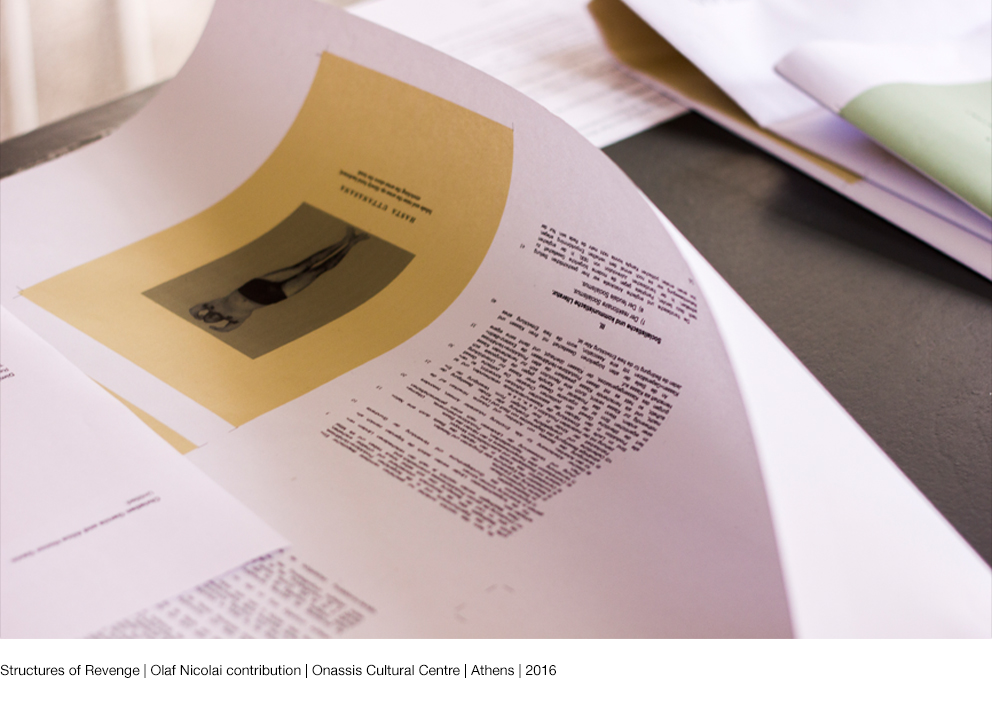

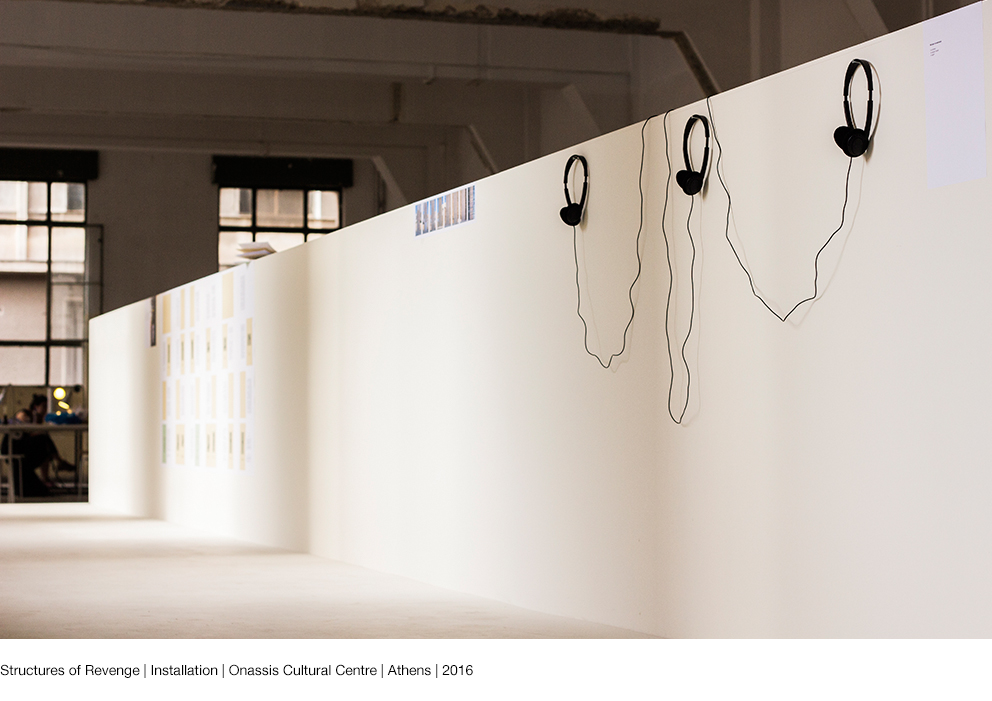

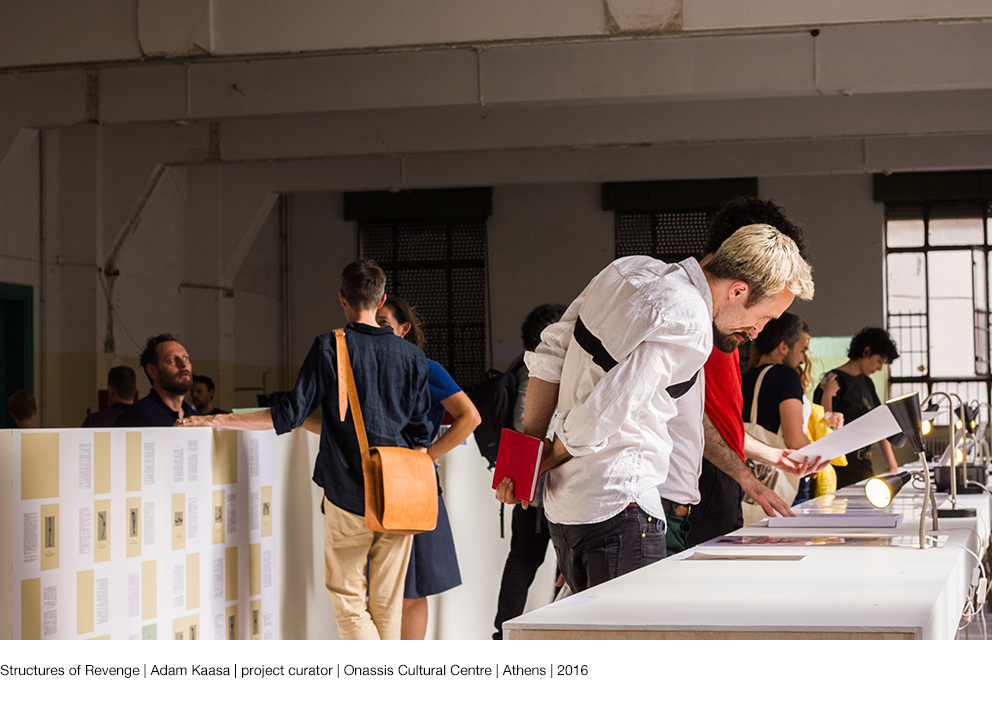
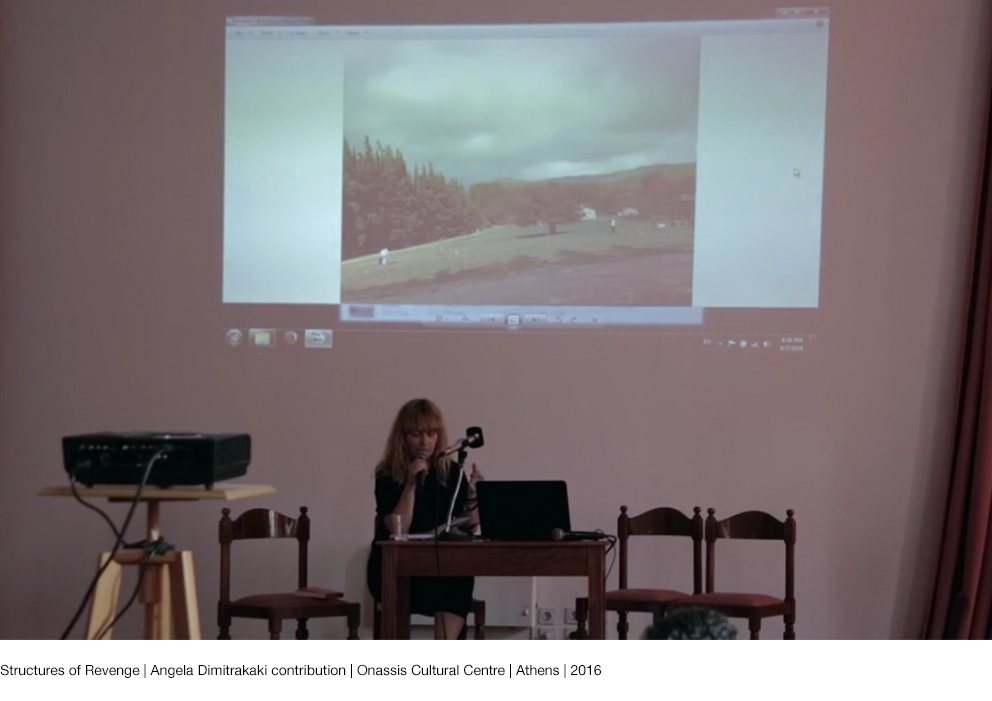
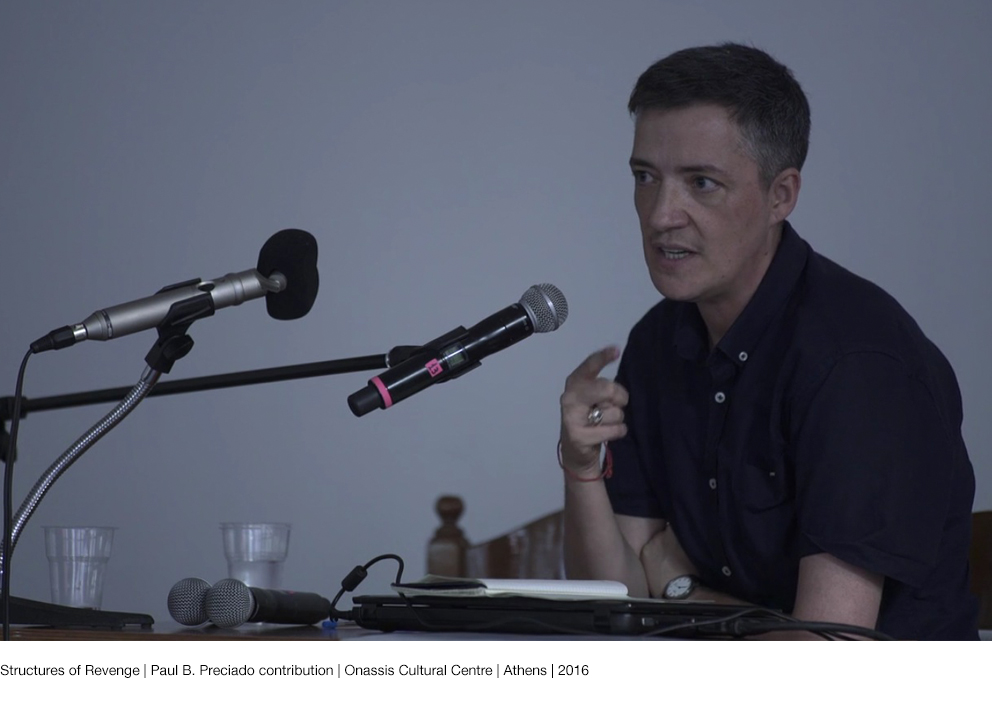


The Structures of Revenge | Complete Discussion
Come to Venice at Annual Conference Città, cittadini, conflitti. Il diritto alla prova della dimensione urbana | Milano-Bicocca University | School of Law | 2017
Il tema Città, cittadini e conflitti consente di esaminare un ampio ventaglio di problematiche connesse all'idea della "città che cambia", intesa come un corpo vivo in continua mutazione che non si lascia facilmente guidare nel suo sviluppo secondo la logica di una pianificazione imposta dall'alto per mezzo di regole politiche, economiche, sociali e giuridiche.
Le sollecitazioni che provengono quotidianamente dalla realtà - si pensi a titolo di esempio al dibattito sullo ius soli e sugli accresciuti poteri di ordinanza dei sindaci - evidenziano la necessità di ripensare il rapporto tra la città come spazio architettonico, urbanistico, paesaggistico e come aggregato di persone (singoli cittadini, gruppi, istituzioni).
I decisori politici devono saper gestire quotidianamente una realtà urbana che si fonda su contraddizioni e conflitti che possono scaturire da fenomeni come - ad esempio - l'immigrazione, la globalizzazione economica, il progresso tecnologico. E' in tale contesto che emergono nuove modalità del vivere insieme, dell'essere appunto cittadini, sotto i profili contrapposti dialogo-non dialogo, inclusione-esclusione, uguaglianze-diseguaglianze, socialità-estraniamento, ecc.
Il tema proposto si presta ad essere esaminato in un'ottica multidisciplinare e comparatistica, coinvolgendo trasversalmente diversi settori del diritto e materie quali, la storia e la filosofia, la criminologia, l'architettura e l'urbanistica, la sociologia e la demografia.
Mediolanum Underground at "Bibe Vivas", curated by Prof. Barbara Biscotti in collaboration with Milano-Bicocca University | Civico Museo Archeologico di Milano | 2015
An ongiong project between a Roman Law Professor and a visual artist, intersecting the discipline of the scientific reaserch with the undiscipline of the art practice, observing the subtle form of a knowledge.
A walk around Milano with a Roman Law Professor looking for ancient Roman ruins among subways, parking lots, apartment blocks. (about 15 photos series, all from film, variable dimension, 2015). The project preview was presented at Civico Museo Archeologico di Milano. Partecipating Professors: Mariavittoria Antico Gallina, archeologist, Universita’ Cattolica di Milano; Barbara Biscotti, Roman Law Historian, Universita’ di Milano-Bicocca; Filippo Maria Gambari, Superintendent of Archeology of the Lombardy Region; Gianfranco Valle, geologist and geoarcheologist.
Technical details
Mediolanum Underground | B/W film photographic series, 30 images.



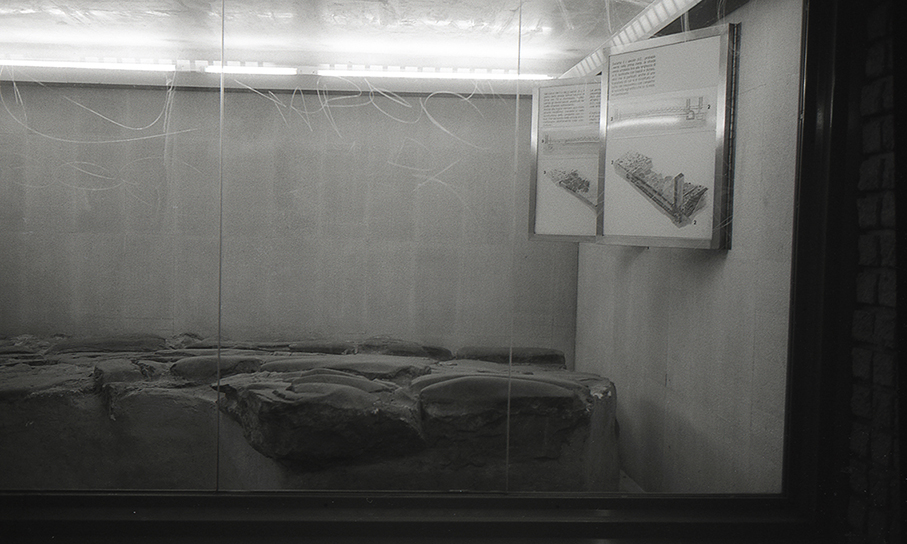





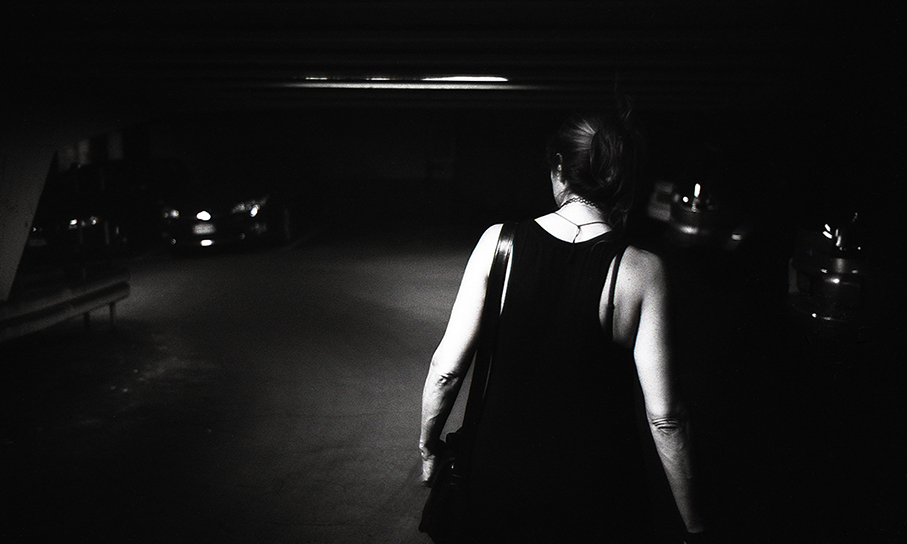
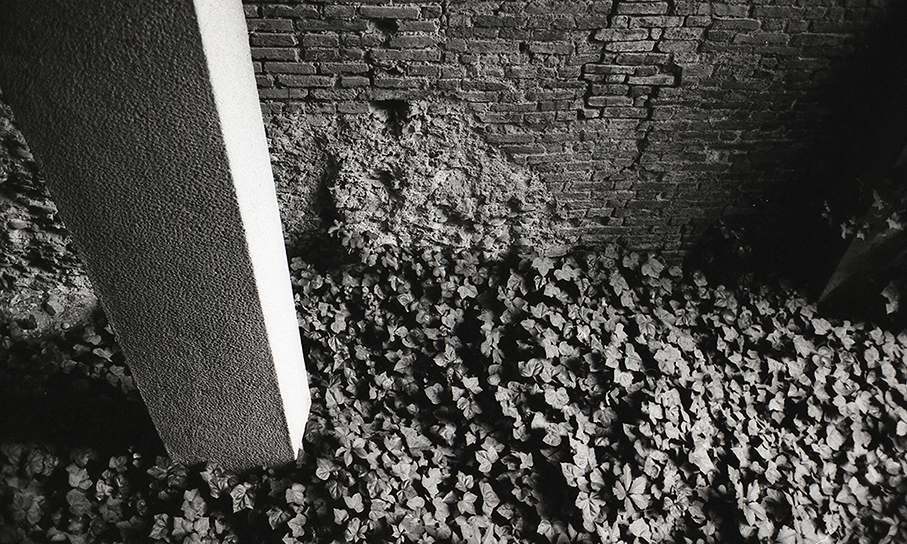
A short interview to Prof. Barbara Biscotti | Der Greif | The sexuality of the exegesis | A work in progress with a Roman Law Professor | https://dergreif-online.de/artist-blog/the-sexuality-of-exegesis-work-in-progress-with-a-professor-in-roman-law/
Come to Venice at Structures of Feelings | Royal College of Art | curated by Adam Kaasa and Yoke Sum Wong | 2015
The title of this meeting is inspired by Raymond William’s Structures of Feeling essay (1977) in which we explore “a kind of feeling and thinking which is indeed social and material, but each in an embryonic phase before it can become fully articulate and defined exchange.” It is this embryonic phase that we give attention to in the experiencing of architecture as immaterial and material and as we navigate its configurations – negotiating towards the affective consciousness of spatial form/s that is at once social and personal – emergent and emerging – in an ‘interrelating continuity’.
How do spatial forms contribute to, as Susan Lepselter writes, an ethnography of emergent feeling? How do we feel architecture and world it – taking worlding as a way of apprehension and comprehension – giving it a structure that we make (non)sense of. The bridging of thought and feeling, the sensations that we encounter in built environments – despair, happiness, joy, fear, dread, hope, disgust nostalgic, warmth and so on – are often evoked instantaneously before we begin to stitch the narratives together or to grasp why we are attuned to the spaces the way we do. Another way of framing it is through Kathleen Stewart’s ‘atmospheric attunements’ which “attend to the quickening of nascent forms, marking their significance in sounds and sights and the feel of something’s touch or something penetrating…[turning] a potentiality into a threshold to the real.”
https://www.rca.ac.uk/news-and-events/events/structures-feelings/
Come to Venice | Winner at The Istituto Veneto’s International Journalism Prize for Venice | 2014
The Prize will reward a press article or a video report on Venice that stands out for its acute understanding of the multifaceted social, economic, natural or artistic aspects of the Venetian situation.
The Prize (€. 5,000) will be presented by a Committee to be appointed by the Istituto Veneto’s Governing Board. The Judging Committee for the 2013 edition of the Prize will include the Institute’s Governing Board and the Members Lady Frances Clarke, Leopoldo Mazzarolli, Antonio Paolucci, Pierre Rosenberg, Wolfgang Wolters and Alvise Zorzi.
The emeritus Chancellor of the Institute, Sandro Franchini, is appointed Secretary of the Committee.
Judging Committee Motivation:
The movie Come to Venice by Benedetta Panisson transcends the documentary level by presenting a sort of 'intimate diary' where some Venetians, whose faces are hidden, tell why they live in Venice, what is missing, what is essential, what they love and what they hate in this city. The voices, alive and sincere, accompanied by the dramatic sound of the sirens of the high tide, become 'collective voices', the expression of a common feeling. The reasons to love Venice and to resist you, despite the hardships, and the final sound of the bells of St. Mark, free your heart from anguish. Originality of setting, excellent quality of filming and editing make this film worthy of the Istituto Veneto per Venezia award
http://www.istitutoveneto.it/flex/cm/pages/ServeBLOB.php/L/IT/IDPagina/355
Come to Venice | Winner at Istituto Veneto di Scienze, Lettere ed Arti Award | 2014
Istituto Veneto di Scienze, Lettere ed Arti | Award Ceremony speech | 2014
Come to Venice at Bozar | Palais des Beaux Arts, Bruxelles | Narratives for change: the united power of people, stories and technologies to induce change | Workshop organized by ECLT | 2014
The event is held under the High Patronage of the Italian Presidency of the Council of the European Union. The workshop will analyze the role of narratives for public engagment at the nexus of science, ICT, and the Arts. The workshop will gather experts from different filds (S&T, policy and the Arts) to discuss ideas and share experiences in public engagement by use of the combined power of narratives, new technologies, and the Arts. The event is organized by EC funded program “Emergency by Design”. Artists, scientists, policy makers, as well as citizens rely on and construct nerratives when they produce artwork, theories, policies, or social movements. Such narratives become part of and forge an identity and are themselves transformed through their use. THe program “Emergency by Design” is setting up a digital platform that allows monitoring such transformations.
Come to Venice is a case study at the European Workshop Narrations and communities, bulding communities for making citizenship, organize by INSITE, Porf. Margherita Russo, and Valentina Anzoise, at Officine Emilia, Modena University, 2014. INSITE is an EU Coordination Acttion whose goal is fostering the dialogue between researchers and practitioners on “How to build a sustainable society, environmentally sustainable and socially responsable”.
Benedetta Panisson talked about: making a message ambigous, deformation and information, emotional structures in an artistic approach/scientific approach, the importance of minority greoups in a community, the performative aspect of hooded people in the “visibility era”, sadian mechanism in Venice. Amerigo Nutolo talked about the first reaction of pleople living in Venice in front of the documentary, a family photobook that you prefer to keep in a closet even if you love every single image of it.
Come to Venice at Ca’ Foscari University | Designing a more sustainable Europe: stories for changes and innovation | Workshop organized by ECLT, INSITE, Ca’ Foscari, 2014
ECLT (European Centre for Living Technologies, Ca’ Foscari interuniversity research centre) investigates the living technologies: artefacts and processes (from nano-scale to social scale) that take form and act based on typical biological process: self-organization, adaption, development. Can an artistic vision and narration produce a sustainable change? Can it show its own story from a differnt point of view?
During the workshop Benedetta Panisson, together with a team of researchers anf project curator, Amerigo Nutolo, tlked about: the dark side of communication, the victim-executioner sadian mechanism, the deep victim point of view, comformism and bourgeoisie as impossiblity of a tragic feeling, the use of the high tide siren as general state of alarm, a community loosing its own sense of community.
Come to Venice case study in a reaserch by Prof. Laura Burocco | Universidade do Rio de Janeiro | published in Concinnitas | Revista do Istituto de Artes da UERJ: https://www.e-publicacoes.uerj.br/index.php/concinnitas/article/view/21191/15273
Concinnitas | Revista do Istituto de Artes da UERJ n.27 | 2016







